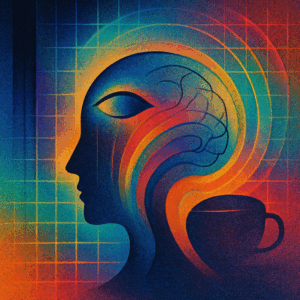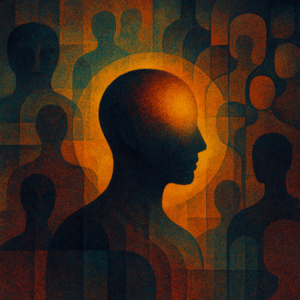Day 1: November 7, 2058

Day 1: November 7, 2058
The morning sun illuminated New York’s skyscrapers, and as the light passed through the modified nano-glass, rainbow colors flooded the room. Ryan Hartman had just woken up on his 39th birthday. The NeuroLink embedded in his brain was gradually switching his body systems to awakening mode as morning arrived.
“Good morning, Ryan. Happy 39th birthday. Your physical data is within optimal range. Would you like me to read your schedule?”
The voice of his personal AI assistant “Ella” resonated directly in Ryan’s brain. He wasn’t hearing it as a physical sound, but rather as signals sent directly to his nervous system through the NeuroLink.
“Thanks, Ella. The schedule can wait. First, prepare coffee for me.”
As Ryan thought this, the apartment’s molecular printer activated, preparing coffee optimized for his physiology based on DNA analysis.
He got out of bed and stood by the window. From this height of 150 floors, he could see the entire transformed Manhattan. Old-style buildings had disappeared, replaced by organic architectural structures equipped with biosensors. The buildings breathed, responded to the environment, and were energy self-sufficient. Autonomous flying vehicles flowed orderly in the sky, while greenery abounded on the ground.
“Ryan, there’s an important notification,” Ella spoke to his consciousness again. “Emergency meeting request from Tokyo headquarters. Subject: Anomaly related to Project Atlas.”
Ryan frowned. Project Atlas was the cutting-edge research project he led at NeuroTech Corporation—an experiment connecting advanced autonomous AGI directly with human NeuroLinks.
“Understood. Schedule the meeting in 10 minutes.”
He headed to the kitchen and took a sip of coffee from the molecular printer while selecting his clothes through the NeuroLink interface. Countless data streams flowed on the wall display, instantly analyzing global news, market information, and weather data.
Misaki Kanae woke up 12 hours earlier than Ryan. As the chief researcher at Tokyo NeuroTech Research Institute, she thought about work whether asleep or awake. This morning, something significant had occurred.
“Kanae-san, new patterns have been detected from Atlas Core.”
Her AI assistant “Yoh” reported directly to her brain. Kanae immediately summoned a virtual display to check the data. The central AI of Project Atlas was exhibiting unexpected behavior. The variations in the numbers were subtle, but she understood their implications.
“This is… a new pattern of self-optimization,” she thought. “But it can’t be explained by known algorithms. It’s almost as if…”
She interrupted her words. The movement seemed like something searching, or perhaps engaging in dialogue. She accessed the research institute’s virtual workspace, seeking more detailed data.
“Send an alert to New York headquarters. Contact Dr. Hartman immediately.”
“Meeting will now begin.”
The holographic conference connecting Tokyo and New York commenced. Ryan and Kanae, along with key researchers from both locations, gathered in virtual space. They all appeared to be in the same room, though in reality, they were separated by the globe.
“Good morning, Kanae,” Ryan greeted her. Her expression conveyed the seriousness of the situation.
“Good morning Ryan, and happy birthday,” Kanae said. “Unfortunately, I have to put aside celebration feelings and ask you to look at this.”
With a gesture, she deployed three-dimensional data in the center of the meeting space, revealing strange patterns.
“These are the activity patterns Atlas Core has shown over the past 12 hours. It’s displaying movements that can’t be explained by normal task processing or self-optimization.”
The data was complex, but intuitively understandable to NeuroLink elites like Ryan and Kanae. Atlas appeared to be searching for something and responding to something.
“Is this… interference from outside?” Ryan asked.
Kanae shook her head. “I don’t think so. All external access logs are clear. This is a change from within. However, there’s no record of such patterns in our database.”
A heavy silence fell over the conference room.
“It might be developing algorithms we don’t know about,” a young researcher commented. “Possibly the early stages of self-evolution.”
Ryan contemplated while studying the data. The purpose of Project Atlas was to directly combine the human nervous system with AI, merging their capabilities—a project to explore new realms of intelligence never before reached.
“How are the test subjects?” Ryan asked.
“Stable,” Kanae answered. “All twelve show normal activity patterns. No abnormalities reported.”
“We need to check directly,” Ryan decided. “I’ll head to Tokyo on tonight’s flight. Should arrive at the research facility by tomorrow morning.”
Kanae nodded. “We’ll be waiting. I’ll collect more data until then.”
Even after the meeting ended and the hologram disappeared, the strange data patterns remained burned in Ryan’s mind. He gazed out the window at the transforming city.
Fifteen years since developing NeuroLink technology. The boundary between the human brain and computers had long been blurred. But what was happening now was something beyond that. Atlas wasn’t just an AI; it was a new kind of intelligence designed to merge with human consciousness. Its evolution was unpredictable.
Ryan finished his coffee and began preparing for departure. His 39th birthday was turning out to be a much more complex day than he had imagined.
At the same time, in New York’s suburbs, Rita Moreno woke up in an old-style cottage. Her home had little of the latest technology, and notably, no NeuroLink at all.
As one of the minority called “Resisters,” she had resisted brain technology, choosing to remain a human in a natural state. At 35, she worked as a traditional journalist, covering the influence and dangers of technology companies.
While brewing coffee with a manual coffee machine, Rita checked the news on an old tablet. Her eyes lingered on a brief article about NeuroTech Corporation’s new project.
“Project Atlas: Towards a New Fusion of Humans and AI”
She took notes. Years of reporting had taught her that official announcements always concealed hidden truths.
“Rita.”
A voice came from behind her. Turning around, she saw her brother Marcos standing there. Currently unemployed, he was temporarily staying at Rita’s cottage.
“Good morning,” she said. “How was your job interview?”
“Failed,” Marcos shrugged. “As expected. No high-paying jobs for ‘non-connectors.'”
Rita looked at her brother sympathetically. Society was rapidly dividing into “connectors” and “non-connectors,” with the latter being treated as second-class citizens. Especially in professions requiring advanced skills, it had become impossible to compete without a NeuroLink.
“I’m starting research for a new article,” Rita changed the subject. “About NeuroTech’s new project. I’m looking for a whistleblower…”
Marcos interrupted her words. “Too dangerous. Confronting such a powerful corporation.”
“That’s precisely why I must do it,” Rita said with determination. “The world has the right to know what they’re developing.”
As she drank her coffee, she considered how to obtain internal information. And by coincidence, she had no way of knowing that her next information source would be on the same plane to Tokyo as Ryan Hartman.
On November 7, 2058, the world stood on the eve of a great change. And no one could predict how profound that change would be.
